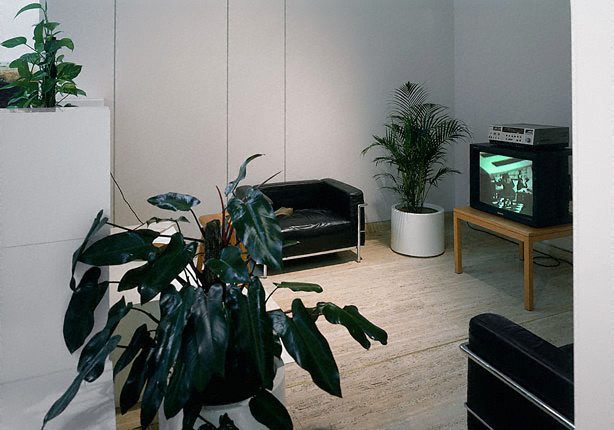


-
Details
- Date
- 1985
- Media categories
- Installation , Time-based art
- Materials used
- VHS video,colour, sound, 21:30 min; stool, 16 white boxes, coffee table, 12 floor tiles, electric toaster, coffee cup and saucer, pot plants, wooden platter, television set, VCR and video guide
- Dimensions
-
installation dimensions variable
:
h - white box, 50 x 50 x 50 cm, all boxes same dimensions
x - linoleum tile, white, 30 x 30 cm, all tiles same dimension
f - terracotta pot, 21.5 x 27 cm
b - electric chrome toaster, 18 x 26.5 x 13.2 cm
e - wooden platter, 20.5 cm
- Signature & date
Not signed. Not dated.
- Credit
- Purchased 1986
- Location
- Not on display
- Accession number
- 95.1986.a-dd
- Copyright
- © Carol Rudyard
- Artist information
-
Carol Rudyard
Works in the collection
- Share
-
-
About
Arriving in Perth in 1970, Carol Rudyard immersed herself in the visual arts. Her earliest works were meticulous and elegant hard-edged paintings but by 1980 when she enrolled in a fine arts degree, she was exploring new media, first in slides and sound and later in video with installation. In these works she rigorously analysed the structural nature of the medium in keeping with the best conceptual art traditions while bringing a rich poetic and often erotic content to their form.
Rudyard’s interest in the writings of Marcel Proust and Stéphane Mallarmé underpins the key concerns of her new explorations, and has continued to influence her artistic vision: in Proust she found a beautiful evocation of the nature of memory and the way it clings to and slides off objects in our everyday lives, while Mallarmé shows how the abstraction of memory attaches to cultural associations. ‘This is ...’ was one of her first video installations and makes this nexus very clear. Its form consists of a simplified reconstruction of her kitchen made in the studio: a stack of glossy white cubes replicates the work bench, the floor is made of plain black and white tiles, a stool stands by the bench, while a bit further away armchairs are placed in front of a television, potted palms are arranged in the space and a highly polished toaster sits on the bench, along with a coffee cup and a plate.
The television is playing a video in which the eye of the camera slowly, meticulously, glides across the surfaces of the objects, as if caressing them in every detail. As the lens reaches the reflective surface of the toaster, it picks up the reflection of the stool’s legs on the black floor tiles but we gradually become aware that something has changed, that these are the legs of another stool on another tiled floor. As the camera pulls back, we discover the image is now Vermeer’s ‘An artist in his studio’ of c1655. The transition is seamless. A soundtrack weaves around the visual image: Rudyard’s voice describes the scene and crosses to passages from Proust while the music of Steve Reich’s ‘Violin phase’ 1967 comes in and out of phase. Rudyard’s voice is mesmerising, closely caressing its subjects in perfect parallel with the sensuality of her visual exploration.
Like most of Rudyard’s subsequent works, her everyday and domestic world is transformed into a rich tapestry of minutely observed qualities which then unfold and connect her solitary life to the world outside her window. Through a complex network of cultural connections, she takes us on a journey from the intimate and ordinary to visions of connectivity and association.
© Art Gallery of New South Wales Contemporary Collection Handbook, 2006
-
Exhibition history
Shown in 3 exhibitions
Australian Perspecta 1985, Art Gallery of New South Wales, Sydney, 22 Oct 1985–31 Dec 1985
Review: works by women from the permanent collection of the Art Gallery of New South Wales, Art Gallery of New South Wales, Sydney, 08 Mar 1995–04 Jun 1995
Penumbrae - Art in the Interstices of the Everyday, Perth Institute of Contemporary Arts, Perth, 16 Jul 1997–17 Aug 1997
Penumbrae - Art in the Interstices of the Everyday, Goldfields Arts Centre, , 29 Aug 1997–21 Sep 1997
Penumbrae - Art in the Interstices of the Everyday, Geraldton Regional Art Gallery, Australia, 10 Oct 1997–30 Nov 1997
Penumbrae - Art in the Interstices of the Everyday, The Cannery Arts Centre, , 20 Feb 1998–29 Mar 1998
Penumbrae - Art in the Interstices of the Everyday, Vancouver Arts Centre, , 08 May 1998–24 May 1998
Penumbrae - Art in the Interstices of the Everyday, New England Regional Art Museum, Armidale, 10 Jun 1998–10 Jul 1998
Penumbrae - Art in the Interstices of the Everyday, Toowoomba Regional Art Gallery, Toowoomba, 13 Aug 1998–13 Sep 1998
-
Bibliography
Referenced in 4 publications
-
Bruce Adams, The Australian Bicentennial Perspecta, 'Carol Rudyard', Sydney, 1987, 95, 96-97 (illus.), 98. This work was not in the exhibition but is illustrated in the catalogue.
-
Anthony Bond OAM (Editor), Australian Perspecta '85, Sydney, 1985.
-
Deborah Edwards, Daphne Wallace, Margo Neale, Victoria Lynn and Sandra Byron, Review: works by women from the permanent collection of the Art Gallery of New South Wales, "Women Artists in the Contemporary Collection", Victoria Lynn, p13-15, Sydney, 1995, 14, 25.
-
Michael Wardell, Contemporary: Art Gallery of New South Wales Contemporary Collection, 'Ideas and actions', pg.60-107, Sydney, 2006, 92, 92-3 (colour illus.).
-
